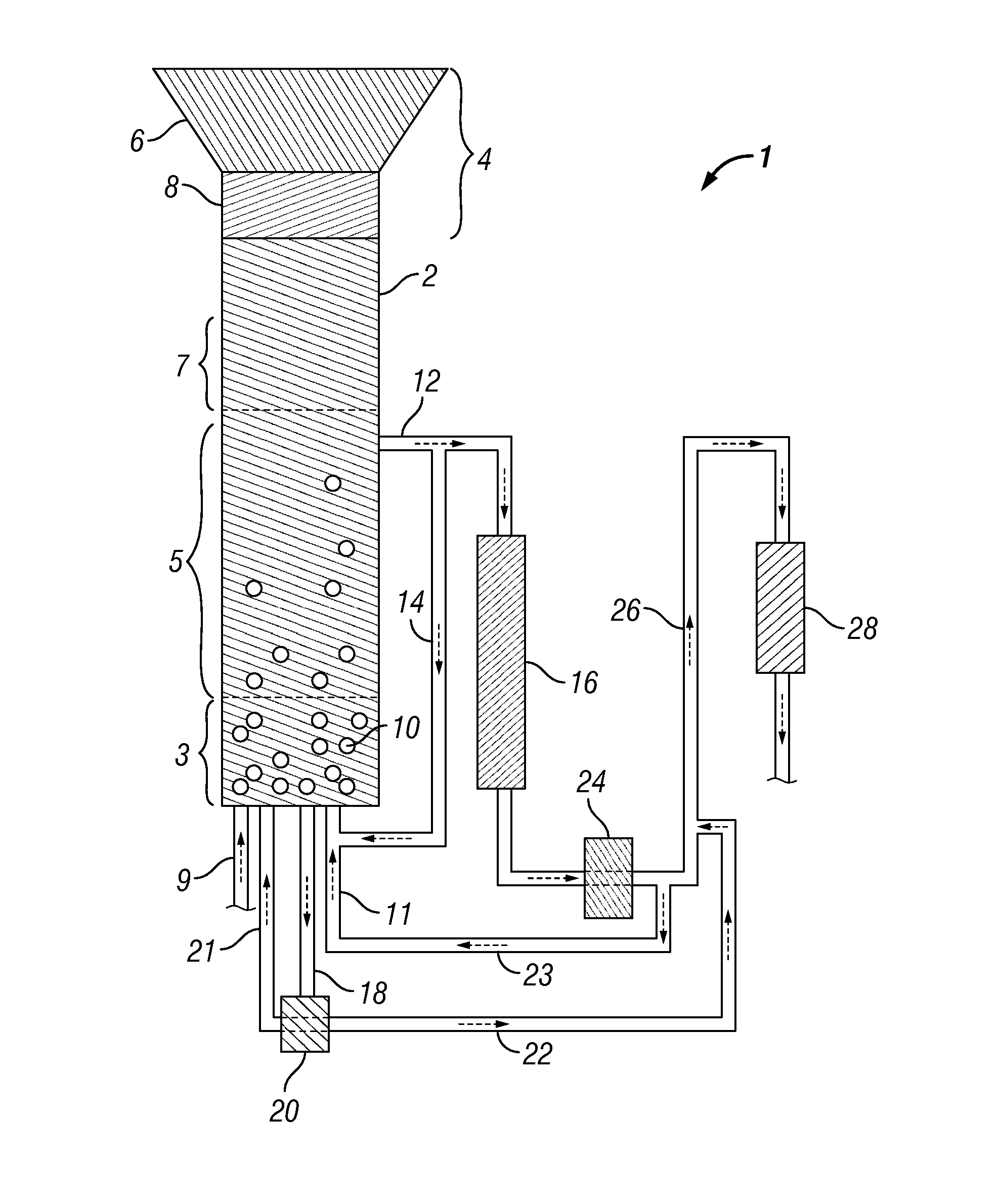Methods and systems for processing lignin during hydrothermal digestion of cellulosic bionass solids
a technology of cellulosic biomass solids and hydrothermal digestion, which is applied in the direction of hydrocarbon oil treatment products, other chemical processes, chemistry apparatus and processes, etc., can solve the problems of slow development and implementation of bio-based fuel technology, difficult processing of lignin, and difficult to deal with lignin in particular
- Summary
- Abstract
- Description
- Claims
- Application Information
AI Technical Summary
Benefits of technology
Problems solved by technology
Method used
Image
Examples
example 1
Formation and Separation of a Phenolics Liquid Phase
[0123]A 75 mL Parr5000 reactor was charged with 20.2 grams of 25% 2-propanol solvent in deionized water, 0.12 grams of sodium carbonate buffer, and 0.302 grams of grams of sulfided nickel oxide promoted cobalt molybdate catalyst (DC-2534, Criterion Catalyst & Technologies L.P., containing 1-10% cobalt oxide and molybdenum trioxide (up to 30 wt %) on alumina, and less than 2% nickel). The catalyst was previously sulfided as described in United States Patent Application Publication 2010 / 0236988, which is incorporated herein by reference in its entirety. The reactor was then charged with 4.98 grams of southern pine mini-chips (39% moisture, nominal dimensions of 3 mm×5 mm×5 mm), before pressurizing with 52 bar of hydrogen. The stirred reactor was heated to 190° C. for 1 hour, followed by heating to 240° C. for 4 hours to complete a 5 hour cycle. At the end of the cycle, the reactor was cooled and allowed to gravity settle overnight. 4...
example 2
Viscosity and Flow Behavior of the Phenolics Liquid Phase
[0126]1.002 grams of the lower phase from Example 1 was placed in a vial on a block heater and heated to 110° C. for 30 minutes to observe flow behavior. No flow of the lower phase was observed upon tipping the vial at 90 degrees, either at room temperature or at 110° C., leading to an estimated viscosity of greater than 10,000 cP. Basis for the estimated viscosity was flow behavior observed in an analogous test with ambient temperature molasses.
[0127]Samples of the lower phase were diluted 1:10 into 50% ethanol and heated to 80° C., upon which a flowable, non-miscible lower phase was observed with an estimated viscosity of 1000 cP. Basis for the estimated viscosity was flow behavior observed in an analogous test with a glycerol standard. A flowable but immiscible lower phase was also obtained by mixing 1 part of the lower phase with 10 parts of 45% propylene glycol / 5% ethylene glycol in deionized water. The lower phase was co...
example 3
High Temperature Reversion of the Phenolics Liquid Phase
[0128]0.306 grams of the lower phase produced in Example 1 were mixed with 0.101 grams of the sulfided catalyst and 0.05 grams of potassium carbonate buffer in a 5 mL heavy wall reaction vial with V-shaped bottom. The vial was carefully heated for 5 hours at 290° C. in a Parr5000 reactor packed with sand for thermal heat transfer under an initial hydrogen pressure of 25 bar.
[0129]Following thermal treatment of the lower phase, it became flowable at 110° C. with no solvent addition required. The viscosity was estimated as greater than 1000 cP. A sample dissolved 1:10 in n-octanol for GC analysis again indicated no detectable peaks having a volatility less than sorbitol. Subsequent analysis of the hydrotreated lower phase indicated the presence of low concentrations of substituted phenols, including propyl phenols.
PUM
| Property | Measurement | Unit |
|---|---|---|
| temperature | aaaaa | aaaaa |
| temperatures | aaaaa | aaaaa |
| temperatures | aaaaa | aaaaa |
Abstract
Description
Claims
Application Information
 Login to View More
Login to View More - R&D
- Intellectual Property
- Life Sciences
- Materials
- Tech Scout
- Unparalleled Data Quality
- Higher Quality Content
- 60% Fewer Hallucinations
Browse by: Latest US Patents, China's latest patents, Technical Efficacy Thesaurus, Application Domain, Technology Topic, Popular Technical Reports.
© 2025 PatSnap. All rights reserved.Legal|Privacy policy|Modern Slavery Act Transparency Statement|Sitemap|About US| Contact US: help@patsnap.com

